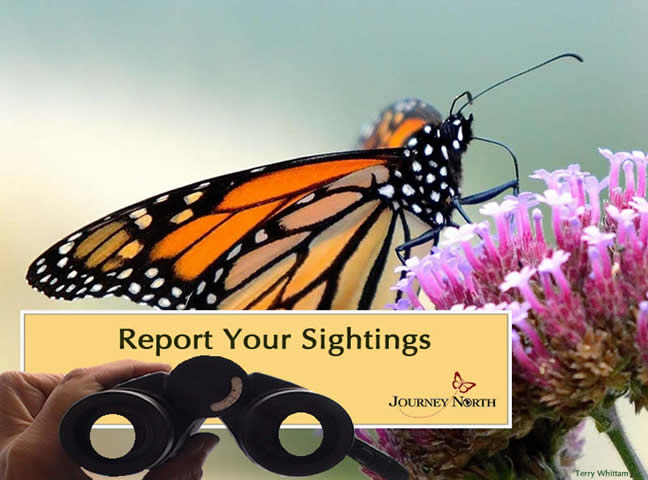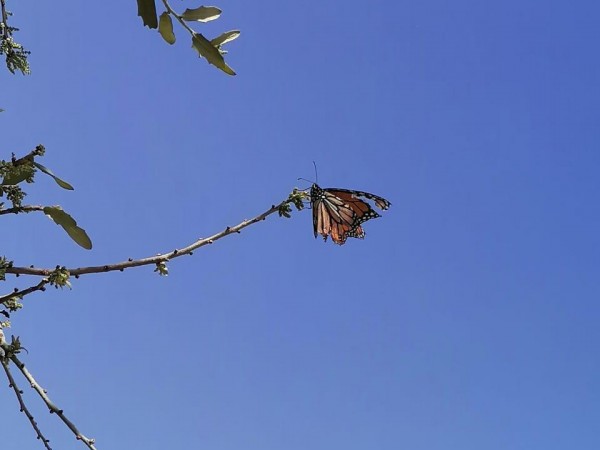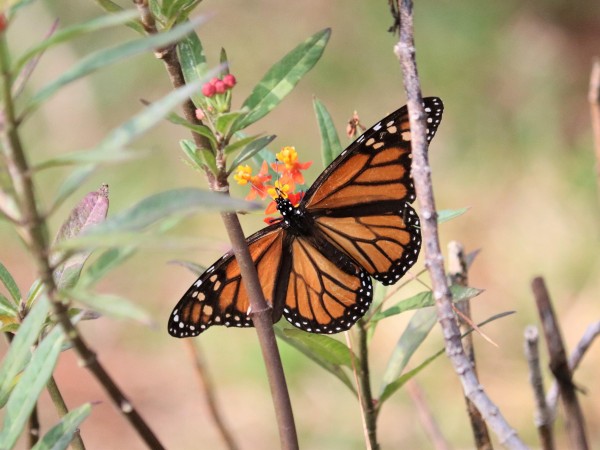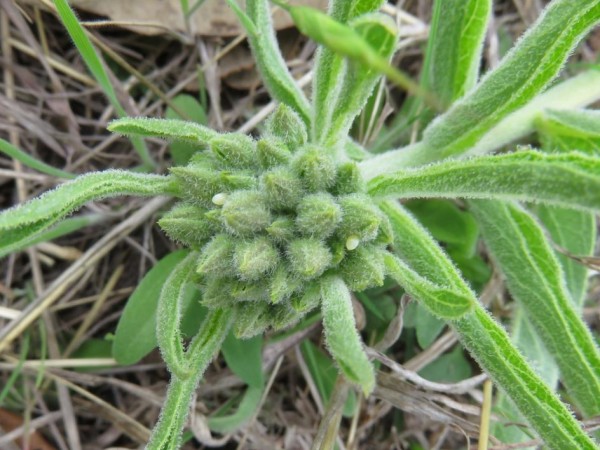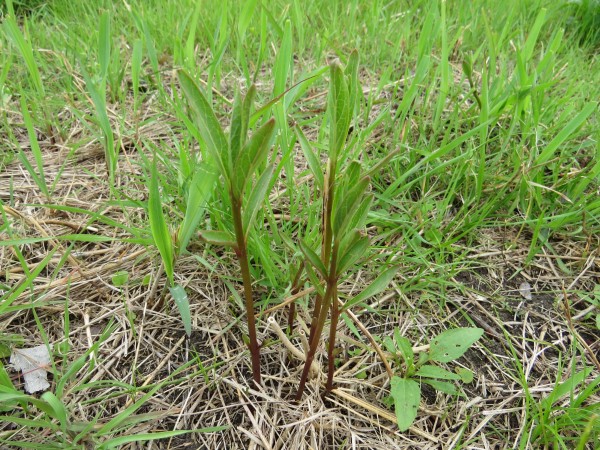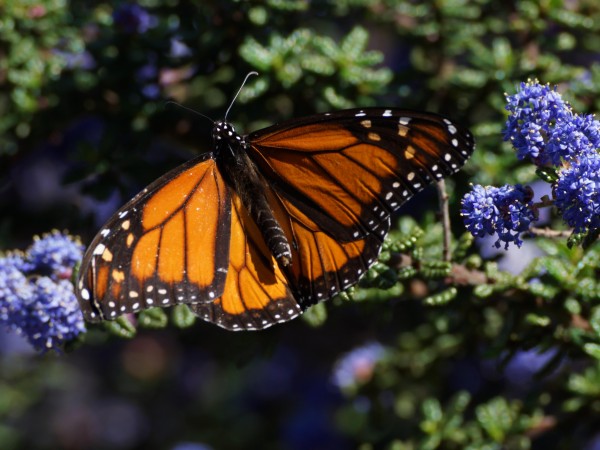Here Come the Monarchs
In Mexico, Estela Romero reports on the remaining colony in La Salud. Gail Morris provides a Western monarch update and highlights reasons for hope. And more reports of migrating monarchs are coming in from Texas. Remember to report observations to Journey North!
Eastern Monarch Population
Letter From Estela Romero: Impending Departure
At Sierra Chincua Sanctuary, Estela Romero shares news that all the monarchs have left. And while the monarch colony at El Rosario Sanctuary also departed, the colony relocated to La Salud where it is still present. She writes, "Two weeks ago monarchs left Sierra Chincua and it is now totally empty . . . the El Rosario colony that moved through Ejido Angangueo a few weeks ago is still beautifully roosting in La Salud . . . It is amazing that despite the intense sun and warmth, with temperatures around 25-27 Celsius, monarchs are still overwintering here . . . Our local communities are all attentive to the impending departure. It could be a gradual, calm departure or perhaps a sudden, massive one. And it could be any day now."
Read more of Estela Romero's Letter: Impending Departure
Leer más de la carta de Estela Romero: Salida Inminente
Thank You, Dr. Ellen Sharp
As monarchs have now fully departed Cerro Pelon Sanctuary, Dr. Ellen Sharp's letters will be on hiatus. We deeply thank Dr. Sharp for taking the time to share news and stories from Cerro Pelon and the surrounding community. These stories shed light on the challenges (especially in a pandemic) and opportunities as well as joys and responsibilities of living in close proximity to a monarch sanctuary. And we also thank Mr. Pato Moreno and Ms. Ana Moreno for their wonderful contributions as well. Stay tuned for a mid-season update from Dr. Sharp!
Migrating Monarchs: Texas is a Hotspot
Reports are largely concentrated in Texas, although the leading edge of migration is as far north as Oklahoma and Arkansas. And reports are still coming in from Mexico as some monarchs are just beginning their journey.
Nereyda Barrios in Linares, NLE: "Six monarchs resting on an oak tree, the one I got a photo of was in very bad shape. Sunny day." (03/14/2021; courtesy of Correo Real)
Sue in Magnolia, TX: "Female. FIRST MIGRATING MONARCH. A different individual than the one posted yesterday, who was also here again today. Note the white spots along the leading edge of the forewings to differentiate the two individuals (that, plus the more faded coloring of this individual)." (03/15/2021)
Katherine in Muskogee, OK: "Adult nectaring on hyacinth around 6pm just on the edge of a wooded area." (03/16/2021)
Cheryl in Springdale, AR: "One lone monarch." (03/16/2021)
Signs of Monarch Reproduction
During spring migration, each female leaves a trail of eggs behind her as she travels. Eggs are already being reported in Texas.
Chuck in Driftwood, TX: "My wife and I walked the perimeter path of our subdivision. It is a 20 foot easement on the eastern side of the property. We spotted 86 milkweed plants and counted 71 eggs. Most of the plants were asperula." (03/16/2021)
First Milkweed Up
February's deep freeze in Texas undoubtedly killed and delayed much milkweed growth. But there is good news to share:
Kathy in Montgomery, TX: "I saw our first milkweed (Asclepias viridis) sprouts today. In addition to the ones in the photo, there was another one in an upper meadow, so more are sure to be emerging soon.The early nectar plants are ready for the monarchs to arrive . . . All are buzzing with bees. Now we are eagerly waiting for the beautiful monarchs to fly in." (03/11/2021)
Western Monarch Population
Letter from Gail Morris: Western Monarch Spring Report #3
Out West, Gail Morris details migration activity in California and the Southwest. She also provides a needed reminder of hope for Western monarchs. She writes, "Cool stormy weather accompanied by high winds at times swaddled California and the Southwest this week. Monarch activity was limited to only the warmest days, but sightings increased in areas where monarchs were already present and multiplied locally . . . The recovery data so far is indicating about half of monarchs tagged in Arizona migrate to Mexico with the remainder to California. We also have small numbers of monarchs trickling in to Arizona across the Mexico border in Spring . . . Your reports of sightings are important! They also give hope for the future of monarchs possibly returning this way to help the dwindling Western population."
Read more of Gail Morris’ Letter: Western Monarch Spring Report #3
Report Your Observations and Include Photos
Your observations provide valuable data to answer many questions about monarchs. If possible, please include photos in your reports. Photos provide indicators such as wing condition to help determine if a monarch is migratory or not. Photos are important because it can be challenging to determine if a first observation is actually a migrating monarch and not a monarch that is overwintering or newly emerged.


